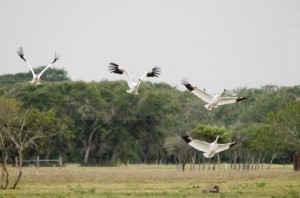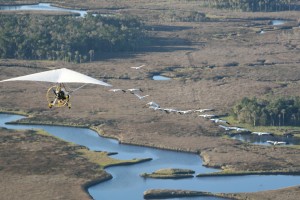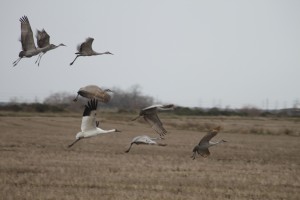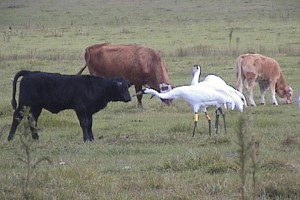By: Chester McConnell, Whooping Crane Conservation Association
Western Whooping Crane Flock
“Only 5 whooping cranes remain on Aransas National Wildlife Refuge as of April 21” according to Dan Alonso, Refuge Manager. All others have begun their migration towards their nesting grounds at Wood Buffalo National Park, Canada. “Only 3 of the 29 whooping cranes carrying GPS transmitters remained on the refuge this past week” said Brad Strobel, Aransas Refuge biologist. Further north on the whooper migration route, Martha Tacha, U.S. Fish and Wildlife Service, reports that, “most of the cranes with GPS transmitters have now passed southern Nebraska and are continuing on their migration north. The cranes are currently distributed from northern Texas to northwestern Saskatchewan with some being within three days flying time of their Canadian nesting grounds. Some of the migrating whoopers were probably slowed last weekend due to the extensive strong storms from Oklahoma through South Dakota.”
with some being within three days flying time of their Canadian nesting grounds. Some of the migrating whoopers were probably slowed last weekend due to the extensive strong storms from Oklahoma through South Dakota.”
Further north on the migration route, wildlife technician Lea Craig-Moore, Canadian Wildlife Services reports that, “Whooping crane migration is in full swing in the Saskatchewan area.” She advised, “We have had the first flush of arrivals in the province and have birds spread from the SE prairie to the NW boreal. Family groups have been seen in a number of locations. Young cranes are learning the preferred stopover sites from their parents as they migrate.”
Eastern Whooping Crane Flock
Most of the whooping cranes in the eastern experimental flock have now reached their Wisconsin nesting area. Wisconsin Department of Natural Resources pilot Bev Paulan conducted an aerial survey April 17th and reported that there are currently 10 active nests located in the core reintroduction area in Wisconsin. Three nests were abandoned earlier. Ten more pairs could possibly nest. Heather Ray, Operation Migration advises that “Hopes are high for baby chicks!”
nests were abandoned earlier. Ten more pairs could possibly nest. Heather Ray, Operation Migration advises that “Hopes are high for baby chicks!”
For several weeks, there has been much interest on the 9 young whooping cranes led south by Operation Migration ultralight planes to Alabama. Due, in part to government regulations, the young birds were finally placed on Wheeler National Wildlife Refuge in Alabama to spend the winter. On April 12 the 9 departed Alabama together on their first unaided journey north. They split into two or more groups during migration, and may be back in Wisconsin as you read this. Not quite a year old, the cranes are too young to pair up or breed. They will wander around the Wisconsin area nesting area and learn how to be whooping cranes.
Louisiana Non-Migratory Flock of Whooping Cranes
On December 1, 2011, a second cohort of juvenile whooping cranes was shipped to Louisiana from the Patuxent Wildlife Research Center. As with the first cohort, the 16 new birds (7 males, 9 females) were initially held in the top‐netted pen. Permanent bands and transmitters were attached to their legs on 8‐9 December and the birds were released into the open pen on 27 December.
On 31 December L4‐10, a survivor from the first cohort, returned to the pen site and joined the 16 chicks. He had spent almost all summer and fall in the marsh just west of the release area and therefore had the strongest ties to the area. The 16 juveniles initially attempted to chase him away and while they continue to keep him away from the food shelter and the feeders they generally became more tolerant of his presence. Food continued to be provided for the birds in the open pen but will soon be discontinued.
site and joined the 16 chicks. He had spent almost all summer and fall in the marsh just west of the release area and therefore had the strongest ties to the area. The 16 juveniles initially attempted to chase him away and while they continue to keep him away from the food shelter and the feeders they generally became more tolerant of his presence. Food continued to be provided for the birds in the open pen but will soon be discontinued.
The young whoopers have shown a similar pattern of movement and pen use to the previous cohort – roosting outside the pen at night but using the pen during the day, primarily in the afternoons. However, with more water across the marsh this group of birds is beginning to range further away from the pen and use areas on the east side of the property which the first cohort did not use.
Florida Non-migratory Flock of Whooping Cranes
Marty Folk, Florida Fish and Wildlife Conservation Commission reports that, “As of 1 February 2012 we estimated there were 19 whooping cranes in the Florida resident population (8 males, 11 females) including 7 pairs. Again, this year, we will study the nesting ecology of these whooping cranes and Florida sandhill cranes. The goals are to determine causes of nest failure, compare the incubation behavior of the 2 species, and determine the efficacy of several research tools for these purposes. The nesting season has begun with our first sandhill crane nest just discovered in Polk County. Drought continues to plague Florida’s wetlands. The northern range of these cranes is very dry and unlikely to support much crane nesting. Fortunately, further south, we have some water for nesting.”
that, “As of 1 February 2012 we estimated there were 19 whooping cranes in the Florida resident population (8 males, 11 females) including 7 pairs. Again, this year, we will study the nesting ecology of these whooping cranes and Florida sandhill cranes. The goals are to determine causes of nest failure, compare the incubation behavior of the 2 species, and determine the efficacy of several research tools for these purposes. The nesting season has begun with our first sandhill crane nest just discovered in Polk County. Drought continues to plague Florida’s wetlands. The northern range of these cranes is very dry and unlikely to support much crane nesting. Fortunately, further south, we have some water for nesting.”

